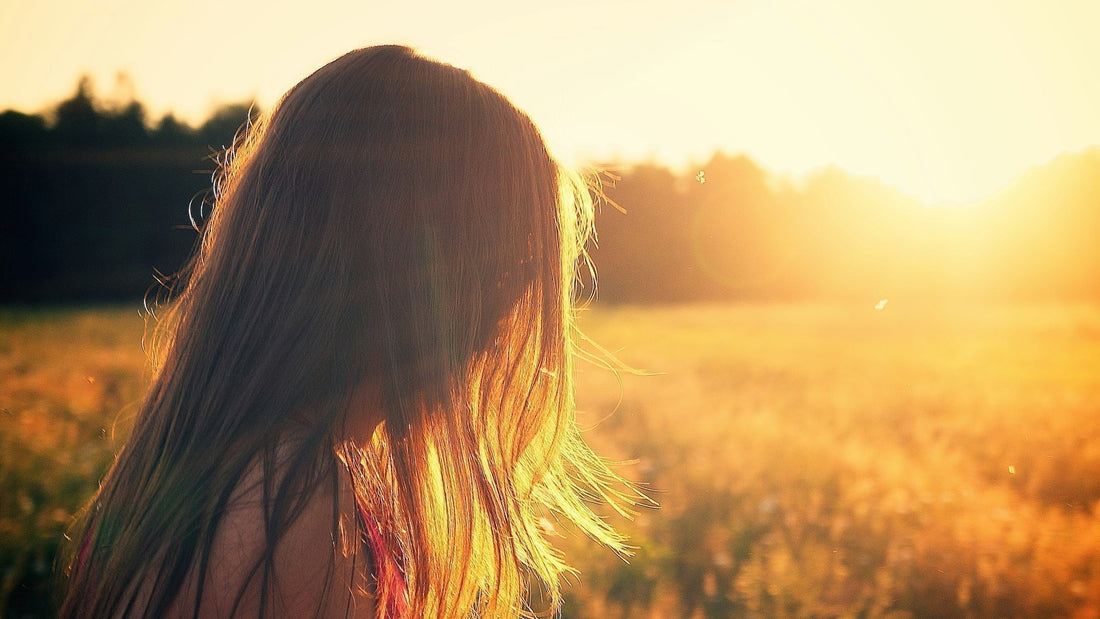God, we love spring! There's something about those first truly warm days that makes everything feel possible again. Just last week, one of our founders was sitting outside at a café with the family, closed eyes, face tilted up like a sunflower, when his teenage daughter smacked his arm and handed over a jar. "Dad, sunscreen!"
She was right, of course. After years running Philab and watching thousands of clients make the same mistake, you'd think we'd know better. But that's the thing about spring sunshine – it feels so good we forget it's quietly damaging our skin.
So, let's see what's happening when spring sun touches our face, why we, people of the city, face unique challenges, and how we can protect ourselves effectively.

The "Spring Surprise" (a.k.a. our annual face-burning tradition!)
It happens every damn year, here at Philab. The temperature hits 24 - 25°C, we spend too long at a friend's garden lunch, and suddenly our face resembles a cherry tomato. The worst part? WE MAKE SKINCARE FOR A LIVING!
Here's what's actually happening: UV radiation doesn't give a damn about temperature. While you're enjoying those lovely warm-but-not-hot sun rays, UVA rays (the sneaky ones) are silently shredding your collagen and elastin like a paper shredder. Meanwhile, UVB rays (the true cellular terrorists) are multiplying their strength faster than Coldplay tickets disappear after a surprise tour announcement! Both are dangerous - one destroys your skin's foundation in silence, the other burns and mutates your cells in real-time, with cancer risk being a real threat that doesn't affect only the "others".
The WHO data confirms what our founder learns the hard way each May – UV levels start climbing dramatically from March onwards. By May, we regularly see UV Index readings of at least 8, in many European countries.
"And how do I know what the UV Index is?" Fair question! Check your phone's weather app – it probably shows this already. The scale runs from 1 (basically harmless) to 11+ (basically the surface of the sun!). Anything above 3 means you should be thinking about protection.
For the obsessively organized among us, here's our quick guide:
- 1-2: Low risk. Still, don't be dumb about it.
- 3-5: Moderate. Cover up when you can, especially midday.
- 6-7: High. Try not to schedule that outdoor coffee between 10-4.
- 8-10: Very high. Full protection or you'll regret it.
- 11+: Extreme. Just... don't (in other words, just stay indoors)

Concrete Jungle Meets UV Radiation
Our founder’s mother moved from the countryside to Athens when she got married. Within a few years, her previously clear skin looked like someone had played connect-the-dots on their face. What the hell is going on?
Turns out city air is basically your skin's nemesis. Traffic pollution, construction dust, and all those lovely fossil fuel particles don't just sit on your skin – they actively bond with it. And when pollution teams up with UV rays? Total disaster. They generate these molecules called reactive oxygen species (ROS) that damage your skin from the inside out.
He remembers trying to explain this to his mother, who insisted her skin issues couldn't possibly be pollution-related because "the air is clean in my neighborhood." When he showed her the pollution index showing PM2.5 (particulate matter) levels three times above what's considered safe, she nearly fell off her chair.
The most annoying part? Studies show that pollution-related aging can actually be worse when UV levels are LOWER. It's like your skin can't catch a break. This is why we tell friends that sunscreen isn't just for beach days – it's literally a shield against your daily commute.

Hydration: The Secret Weapon
Many of us have been grown up with those ultra-greasy sunscreens that caused breakouts, and we spent years thinking hydration and sun protection were totally separate issues. Boy, were we wrong.
We tend to separate sun protection and hydration in our minds, but they're actually inseparable partners in effective skin defense. Pay attention: When your skin becomes dehydrated, its protective barrier weakens, allowing more environmental aggressors to penetrate and amplifying UV damage.
Picture trying to protect a dried-out sponge versus a damp one. The dry one cracks easily, while the hydrated one stays flexible. Your skin is exactly the same.
The science nerds at Philab (we have a couple of them) might appreciate knowing that low molecular weight hyaluronic acid actually penetrates deeper than regular HA. When we combine this with ingredients like sunflower oil or shea butter, it creates this amazing hydration matrix that dramatically improves your skin's ability to handle stress.
Eva, Philab team member, keeps telling her skeptical younger sister: "You wouldn't expect a dehydrated athlete to perform well, so why expect that from dehydrated skin?" She still doesn't moisturize consistently, and at 35, let's just say people think Eva is the younger sibling now.
What Actually Works: Real Talk
Look, we already know it. Most days, most of us are racing from dropping kids at school to the office and the various evening work/family obligations. And that elaborate 12-step skincare fantasy routine that we read in beauty blogs and magazines? It happens maybe twice a year.
Here's what actually works for real humans with real lives:
First, non-negotiable SPF. Every. Single. Morning. We don't care if you're planning to live in a basement all day – just do it. It takes 15 seconds.
Second, reapply. No sunscreen lasts all day, regardless of what the marketing promises. Set a phone reminder to reapply every 3 hours when outdoors. Keep a jar in your bag right next to emergency chocolate (priorities, people!).
Third, please, remember your neck and hands (and ears)! Nothing gives away your age faster than a 35-year-old looking face sitting on top of a 60-year-old looking neck. These areas have thinner skin with fewer oil glands.
Fourth, hydrate like you mean it. Apply moisturizer while your skin is still damp from washing. Choose barrier-supporting moisturizers and look for ingredients that strengthen your skin's natural defense systems. Also, drink water, plenty of it.
Fifth, antioxidants are your friends. Layer a serum with antioxidants under your sunscreen to deal with whatever your SPF misses. Think of them as your skin's cleanup crew.
Too many steps? Yeah, we thought so too. But what a coincidence! We happen to know one product that was created with all the above in mind! Philab’s Extra Moisturising & Anti-pollution Cream SPF25. After listening to people complain about needing 47 different products, and because many of us are a little bit lazy when it comes to daily skincare, we made one that does everything: deep hydration, reliable sun protection, and environmental defense in one single step. Our entire team uses it daily because we can slap it on while running out the door and still feel like responsible adults.
Real Talk from Real People
Our favorite customer feedback came from Sophia in Thessaloniki. She left a review in our e-shop: "Fantastic cream. I’ve been using it for years, winter and summer. Its high SPF means I no longer get dark spots on my forehead like I used to. Plus, it’s deeply hydrating. I combine it with the anti-aging serum, and the results are outstanding."
Feedback like that makes all those sleepless nights working on the formulas totally worth it.

An Advice from the Far East and your Checklist...
Our founder shares a story of his Taiwanese – living in Athens – friend, Vivian, when her mother came to visit her (what a great chance for a real mom-cooked Taiwanese dinner). Anyway, he met this woman who was 68 but looked maybe 50, with the most incredible skin he’d ever seen. When asked about her routine, expecting some complex 20-step ritual, she simply said, "I’ve always thought of the sun like my mother-in-law, wonderful in small doses, but keeping a distance, avoids the drama!"
Smartest skincare advice we've ever heard!
So enjoy your spring, friends. Sit in that sunshine – just do it wisely. And if you see someone frantically applying sunscreen while balancing coffee and a laptop outside a café (probably dropping everything in the process), give them a smile. They might be part of our Philab family, the ones who've learned that a few extra seconds each morning means much better skin in the long run.
Finally, (we repeat ourselves, we know), your – take it seriously - Spring Checklist:
- Check the UV Index on your weather app (seriously, it takes 2 seconds)
- Apply broad-spectrum SPF25+ daily (even if you're "just running errands")
- Reapply every 3 hours, when outside (keep a jar in your bag and set a reminder, you'll forget)
- Use antioxidant products (a serum under the moisturizer works wonders, ask us!)
- Hydrate your skin consistently (just like you should be hydrating your body)
- REMEMBER YOUR NECK AND HANDS (we're shouting because you'll forget)
- Consider multitasking products if you're as busy or always in arush, as we are (and you know we've got the best one!)
P.S. If you become the sunscreen evangelist in your friend group, we apologize in advance. Some of us have been banned from talking about UV damage at family gatherings. Apparently, we "ruin the vibe." But it's worth it!


